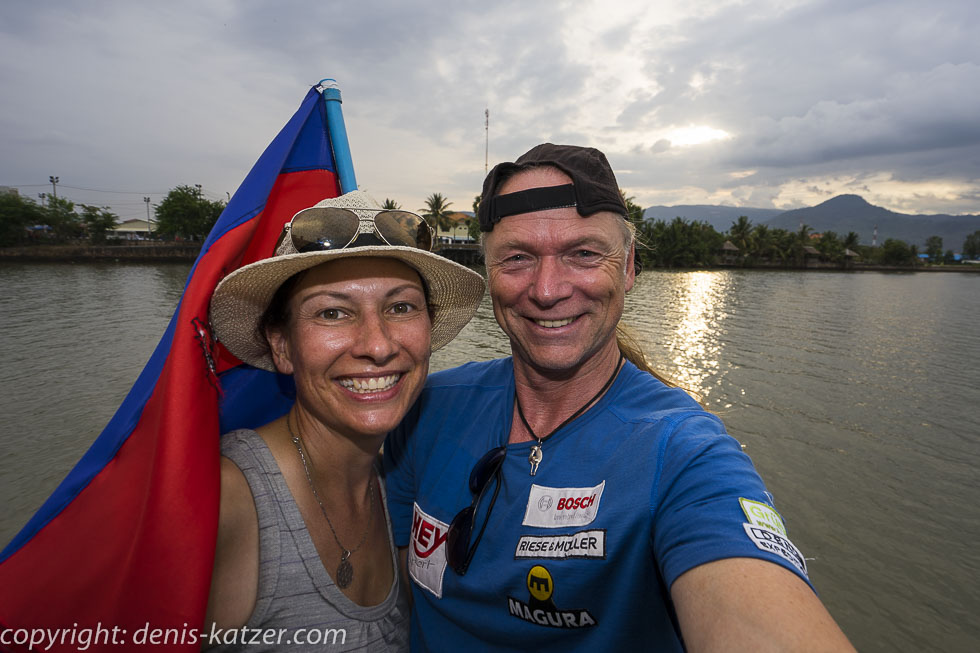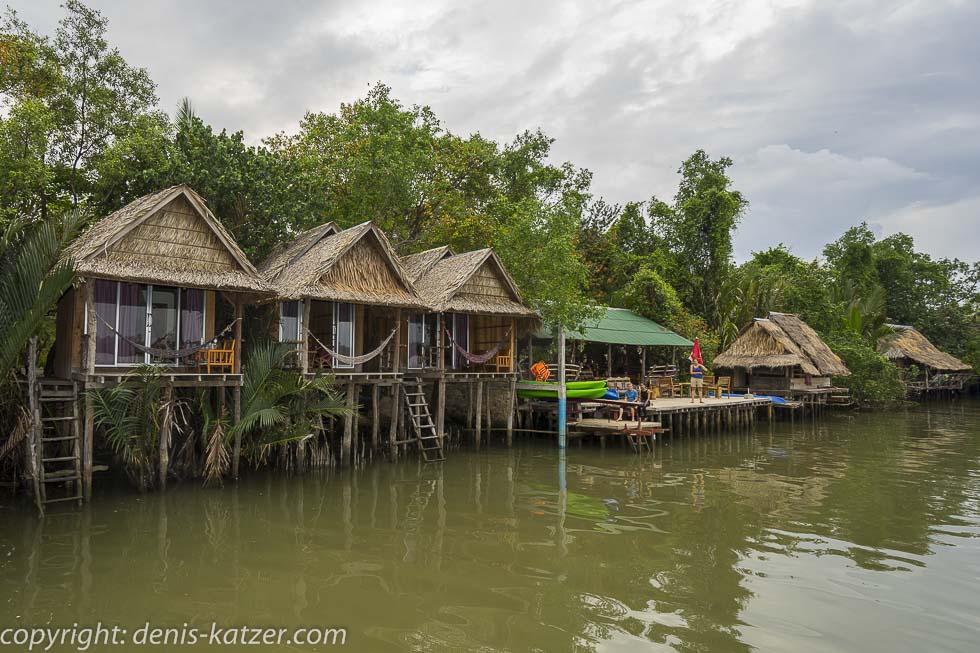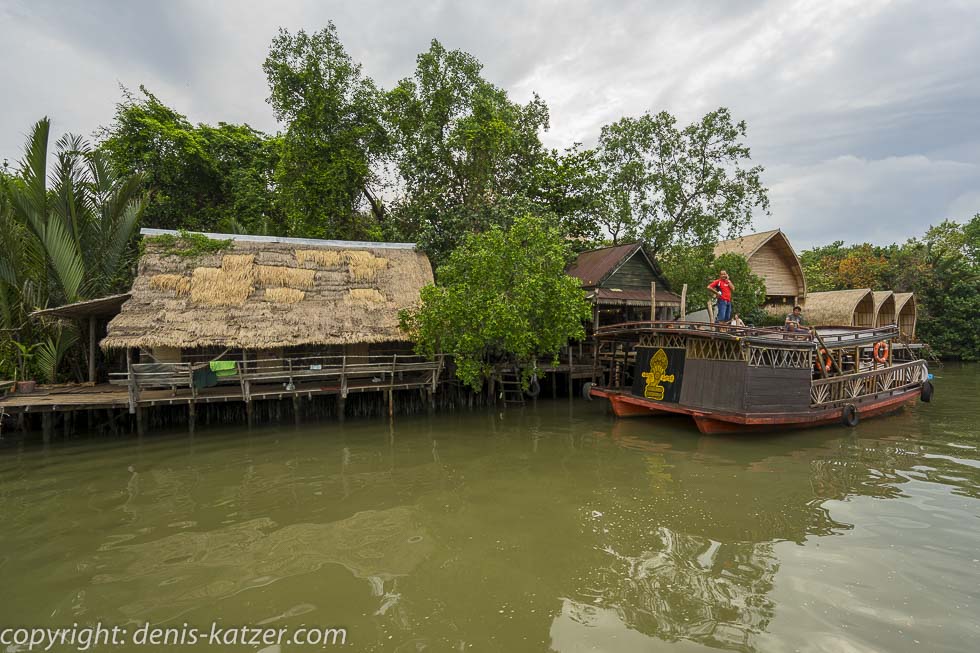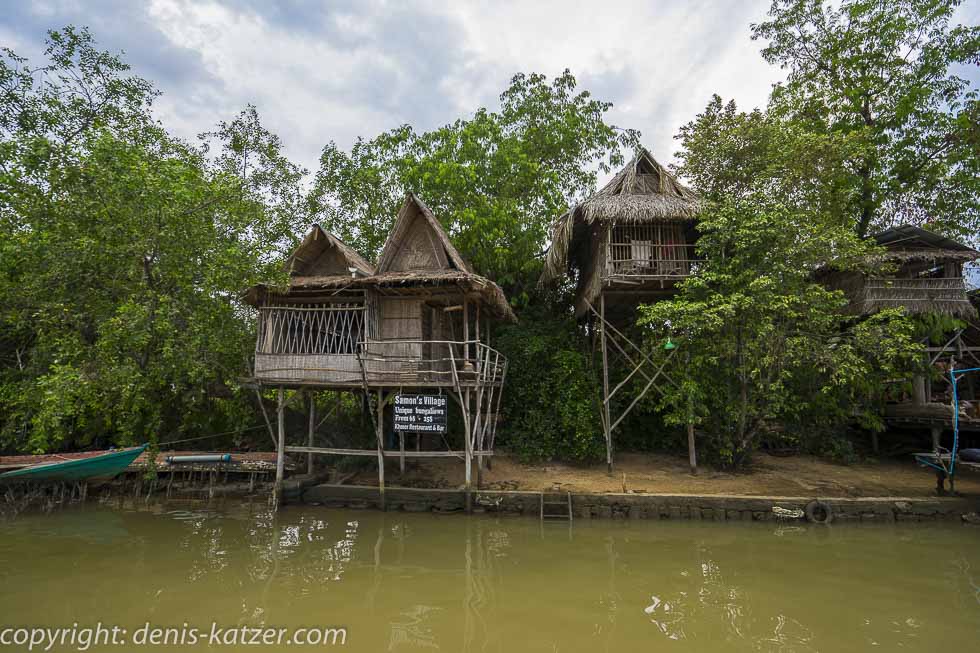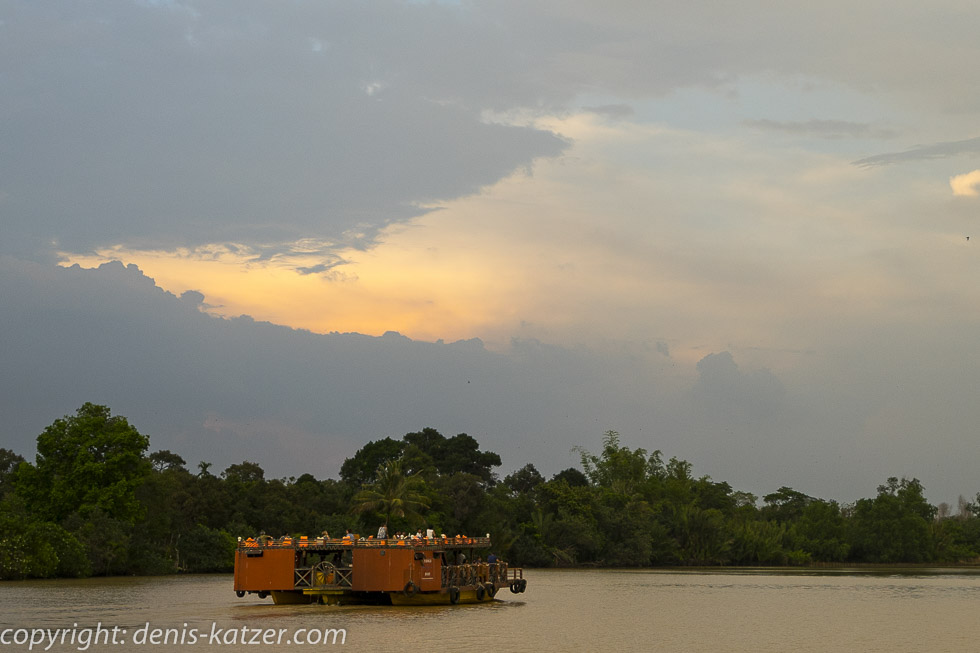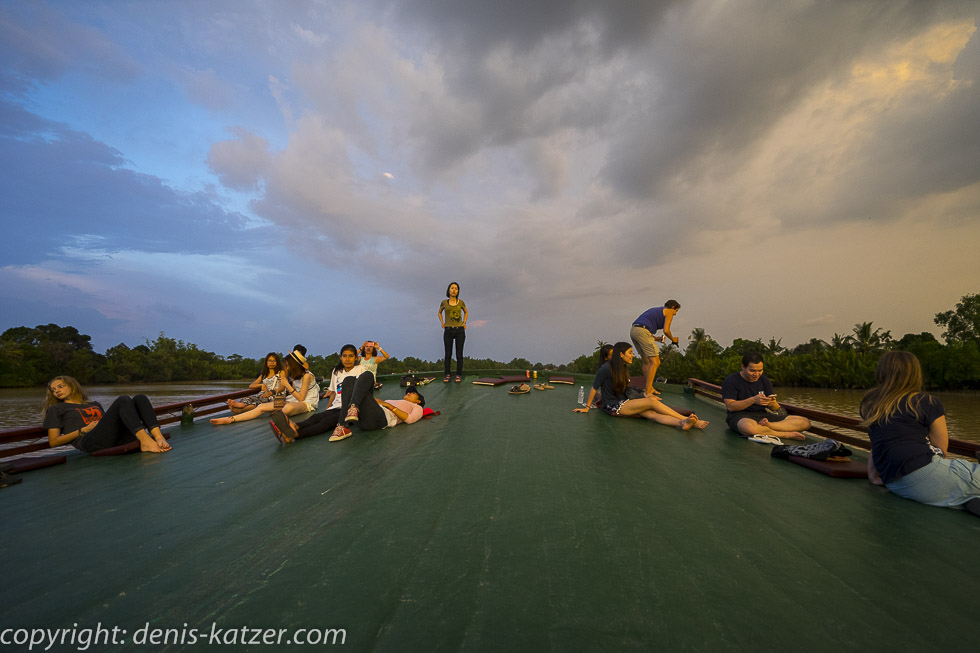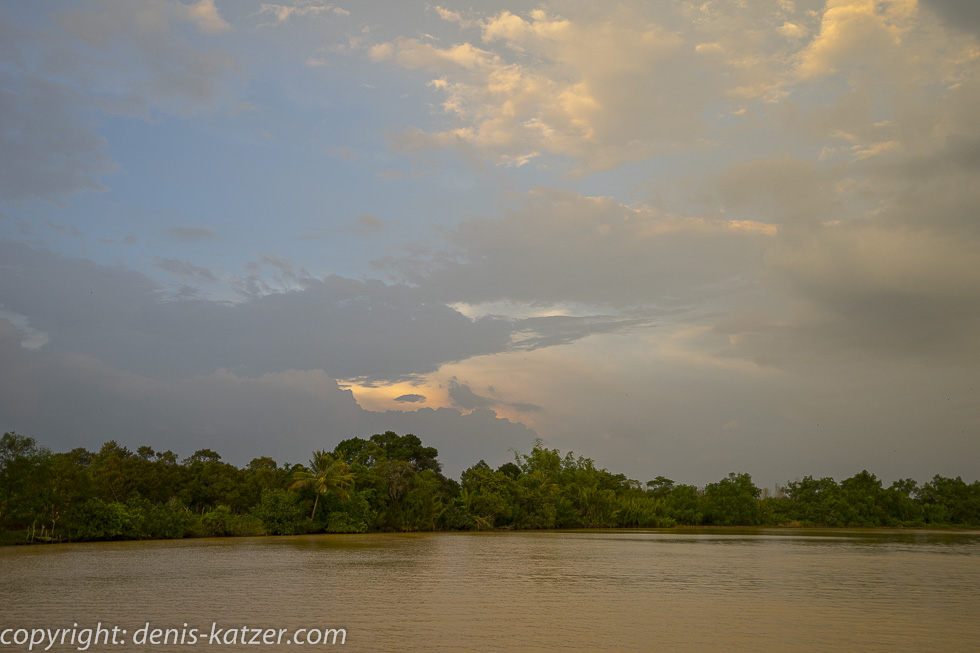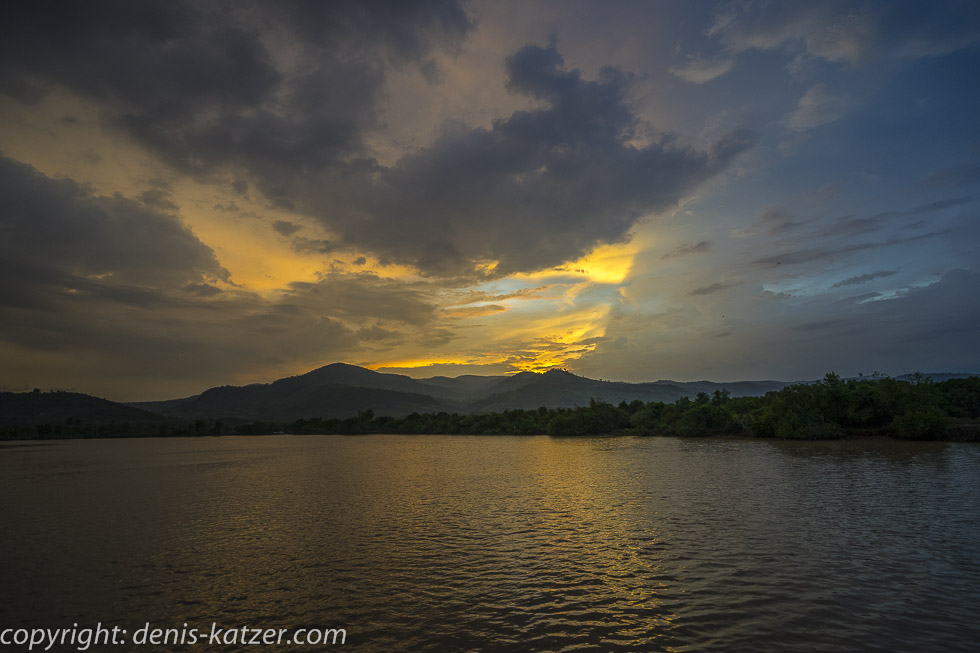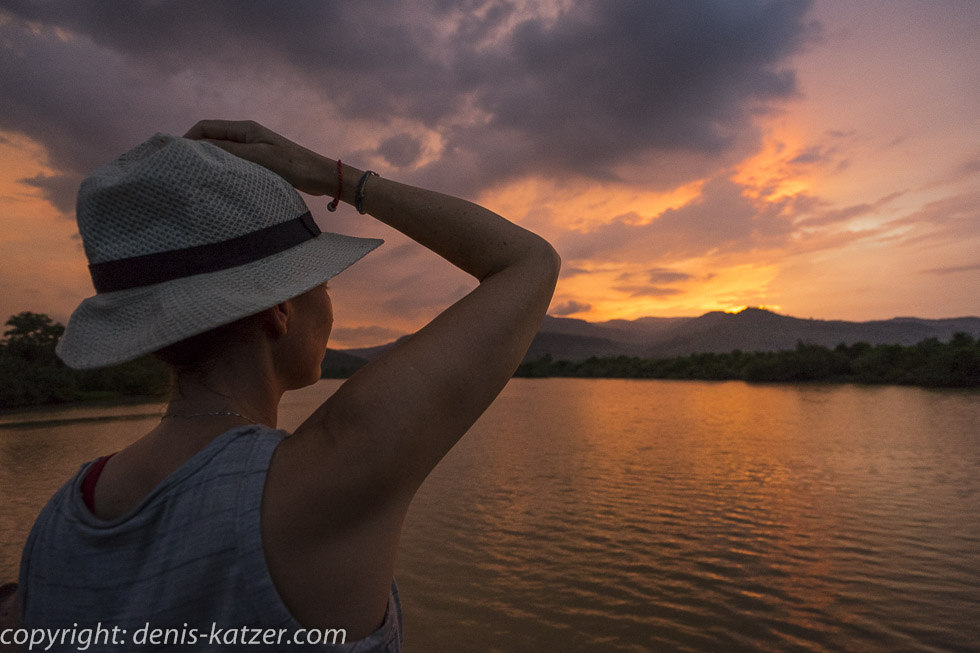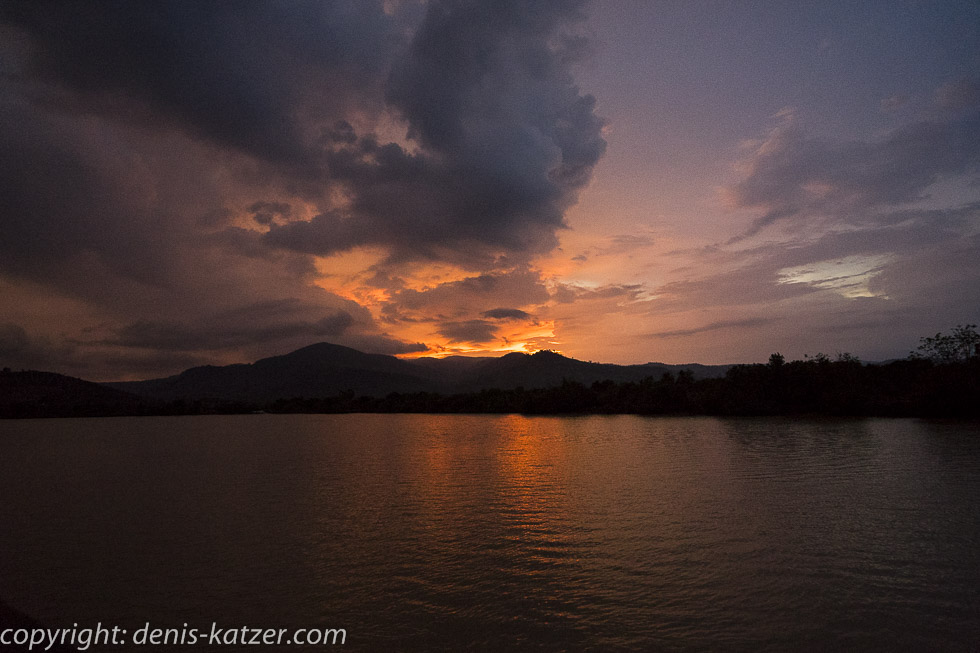
River trip into the world of colors – the decline of a country
N 10°36'39.0'' E 104°10'25.3''
Date:
06.04.2017 until 09.04.2017
Day: 646 – 649
Country:
Cambodia
Province:
Kâmpôt
Location:
Kampot
Latitude N:
10°36’39.0”
Longitude E:
104°10’25.3”
Total kilometers:
23,393 km
Total altitude meters:
70.571 m
Sunrise:
05:57 a.m. – 05:56 a.m.
Sunset:
6:14 pm
Temperature day max:
31°C
(Photos of the diary entry can be found at the end of the text).
LINK TO THE ITINERARY
On one of the evenings, we decided to take an excursion boat on the Teuk Chhou River. We sit on the roof of the barge and look out over simple thatched huts standing on the shore. In front of some of the huts, makeshift bamboo terraces sway on the lazily flowing river. Travelers sit on it, taking a drag from a cigarette. The smell of marijuana wafts over to us with boisterous laughter. A few kilometers further on, dense mangrove and tropical forests line the shore. They stand out against the cloudy, stormy sky like a silhouette. In the background we can see the foothills of the Elephant Mountains with the Bokor National Park, where 100 elephants and a few Bokor tigers are said to still live in the wild. The further the evening approaches, the further the sun retreats to the other side of our Mother Earth, the more powerful the sky’s play of colors becomes. We watch, spellbound and fascinated, as a mixture of all shades of yellow creeps into the storm clouds, as the colors change incessantly. As if a mighty hand were stirring the vault of the sky with a stick, the intensity increases or decreases incessantly, moving as if in waves, currents, turbulence and, quite imperceptibly, all yellow has disappeared, only to pulsate in a mixture of even more beautiful orange or blood red. As the last hint of color is absorbed by an all-encompassing black, blinking little creatures of light buzz through the dark foliage of palm trees and jungle plants. “Beautiful,” Tanja says quietly, as if every word spoken too loudly would drive the fireflies away. “Fascinating,” I say, equally muffled, and at that moment I realize that I have arrived in the Kingdom of Cambodia.
My mind wanders and I wonder what surprises the Southeast Asian country, which lies on the Gulf of Thailand and borders Thailand, Vietnam and Laos, has in store for us. In my mind’s eye, I can see Cambodia on the globe, which is almost 2 times smaller than Germany and 53 times smaller than the huge China, which we also cycled through on this trip. A country in which only just over 15 million people live, in whose capital Phnom Penh the average monthly income is around US$ 66 and in the countryside around US$ 12. There is no doubt that many inhabitants of the old kingdom are very poor, even poorer than in the neighboring countries of Vietnam and Thailand.
It is strange that a people who had their first settlements 4,200 years ago and experienced a heyday between the 9th and 15th centuries should experience such a huge regression. It is strange that a people who had their first settlements 4,200 years ago and experienced a heyday between the 9th and 15th centuries, dominated Southeast Asia from Malacca (a city in present-day Malaysia) to the Isthmus of Kra (the isthmus connecting the Malay Peninsula with the Asian continent) as well as Laos and parts of Vietnam, whose capital Angkor was already home to around one million people in 1200, making it the largest city in the world at that time, which produced cultural sites such as the World Heritage Site, the largest temple complex in the world Angkor, or Roluos, Banteay Srei and Preah Vihear.
However, the turbulent past of the entire region shows how wars weaken, destroy or create new countries. As early as 1177, the Cham people living in what is now southern Vietnam conquered the Khmer capital of Angkor for quite some time. However, 13 years later they were driven out again by the Khmer. Angkor was conquered by the Thais in 1353. Although they soon withdrew, they conquered Angkor again in 1431.
Considering that wars with neighboring Thailand and Vietnam broke out incessantly in the following centuries, it is no wonder that this empire was severely weakened. In the end, Vietnam conquered 17. and In the 18th century, Thailand took over most of the Mekong Delta and the north of the shaken country.
In order not to sink completely, Cambodia sought protection from the colonial power France, which took over the southern part of Vietnam in 1859. Certainly an act of desperation because protection never comes for free in this world. This was also the case in Cambodia, as the country ultimately lost its freedom because the French appointed French officials from 1884 without asking King Norodom, and the country thus became a de facto colony of France.
After the kingdom finally got rid of the hostage of oppression in 1953 and the colonial power France withdrew from this part of the world, a terrible civil war broke out which cost immense victims among the population and destroyed the country economically. But that was by no means all, because the Vietnam War followed. Although Cambodia remained neutral in this terrible war, the kingdom was dragged into it by the Americans. The Americans attempted to destroy the Ho Chi Minh Trail in the eastern part of Kamboscha through large-scale bombing, so that the Viet Minh could no longer deliver supplies from North to South Vietnam.
As if that were not enough to finish off a country, the failure of international politics brought the mass murderer Pol Pot (real name Saloth Sar) to power, who was responsible for the deaths of 1.7 to 2.2 million Cambodians from 1975 to 1978. With a population of just over seven million people at the time, over a third of the entire population was wiped out under his leadership. Half of the population was shot, beaten to death, beheaded with hoes or suffocated with plastic bags. Small children were crushed by trees. The other half of the people died as a result of forced labor, hunger and inadequate medical care. The Khmer Rouge, which had its origins in the Communist Party of Cambodia and was led by Pol Pot, was a Maoist-nationalist guerrilla movement that came to power in Cambodia in 1975 and only disbanded in 1998. The process of coming to terms with the crimes of the Khmer Rouge, which cannot be described in words, only really began at the turn of the millennium and is still ongoing today. Certainly many of the criminals of that time are still at large or have gone into hiding in leading positions.
Even the current Prime Minister Samdech Hun Sen, who is regarded as severely corrupt, served as commander of a Khmer Rouge regiment in the Eastern Administrative Zone from 1975 to 1977. Although he is regarded as absolutely ruthless and allegedly does not shy away from murdering political rivals and opponents, he has remained in power since 1985.
Pol Pot, one of the greatest mass murderers in the history of mankind, died on April 15, 1998. To this day, it is not certain whether he took his own life or was killed.
Tuck, tuck, tuck, the heavy diesel engine of the excursion steamer rings in my ears and takes me out of my thoughts. The air is hot and humid at around 31 °C. However, the fireflies have gone out. In front of us are the colorful lights of the tourist town of Kampot. The mood of the people on our boat is exuberant and does not match the country’s gruesome past. And yet the old kingdom of Cambodia has changed massively since the end of the Khmer Rouge. However, the population has more than doubled to just under 16 million people. Thousands of tourists from all over the world can travel the country safely and without hesitation. The government promotes tourism and attracts investors and long-term travelers from all over the world with easy-to-obtain business visas. If you leave the country’s recent history behind, overlook the massive corruption, the sale of the last rainforests to Vietnam and China, and the incredible environmental destruction, you can really feel at home here. I tell Tanja about my thoughts and ask her, as I often do, whether I should even write all this down. “Write about it, but don’t let it get to your heart so much. We will travel to Cambodia, not let the terrible past catch up with us and ignore the corruption as much as possible. I’m sure we’ll have a wonderful time here and still be able to report objectively about the country.”…
If you would like to find out more about our adventures, you can find our books under this link.
The live coverage is supported by the companies Gesat GmbH: www.gesat.com and roda computer GmbH http://roda-computer.com/ The satellite telephone Explorer 300 from Gesat and the rugged notebook Pegasus RP9 from Roda are the pillars of the transmission.
